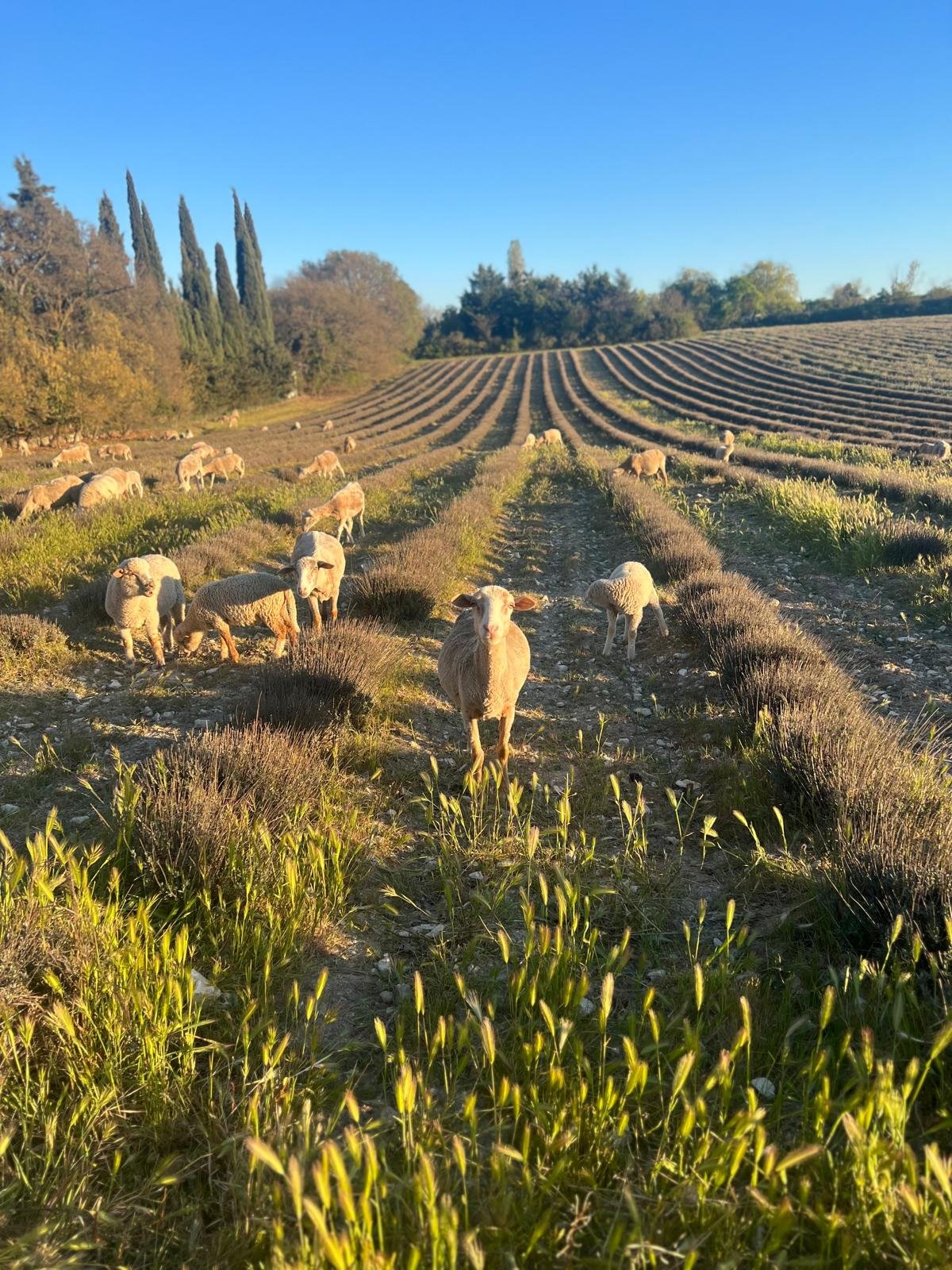What is eco-grazing?
At a time when environmental issues are at the heart of our collective priorities, eco-pasturing is emerging as a solution that is both ecological and economical, and consistent with the rhythms of nature. This practice involves grazing animals on green spaces to maintain them, replacing traditional mechanical means.
At Terre Ugo, eco-pasturing is fully integrated into our reasoned approach to lavender cultivation and our desire to offer a living place that respects its environment and those who visit it.
A simple definition of eco-pasturing
Eco-pasturing is based on a simple principle: replace lawnmowers with herbivores. Sheep, goats, donkeys or even cows maintain the land by grazing on the vegetation, while respecting the ecosystems present.
Unlike mechanical maintenance, which standardizes the soil and can deplete biodiversity, eco-pasturing enables differentiated management of green spaces. The animals select what they eat, leaving certain species untouched, favoring wild flowers and contributing naturally to soil fertility.
Why choose eco-pasture?
Reduced environmental impact
Eco-pasturing significantly reduces the use of combustion engines, which often consume a lot of fuel and emit greenhouse gases. It also avoids the use of chemicals such as weedkillers, which can harm soil, groundwater and local biodiversity.
As for the animals, they work silently, emit no pollution and enrich the soil with their natural droppings. This management method respects ecological balances and is fully in line with a sustainable approach.
Preserving biodiversity
By grazing selectively, eco-pasture animals maintain the environment while leaving room for a variety of flora. This plant diversity attracts numerous pollinating insects, birds and other species that contribute to the richness of life. Unlike mechanical cutting, which standardizes and impoverishes the land, eco-pasturing creates dynamic, living spaces that are constantly evolving.
Eco-pasturing is particularly useful for land that is difficult to access, sloping or sensitive (wetlands, riverbanks, embankments, etc.). The animals move around easily and carry out regular maintenance without damaging the soil. What's more, this method can be adapted to suit specific objectives: keeping grass short, combating invasive plants, clearing undergrowth...
A Viable Economic Model
Beyond its ecological benefits, eco-grazing is a competitive solution from an economic standpoint. It helps reduce costs associated with mechanical maintenance: fuel, maintenance, skilled labor, noise, logistics... In the medium term, the savings are significant, especially for large areas.
Some regions also choose to work with local farmers or specialized providers, thereby supporting rural and artisanal networks.
Eco-Grazing at Terre Ugo
Located just a few kilometers from Aix-en-Provence, the Terre Ugo estate is a place where lavender is cultivated with passion and respect for life. In line with this approach, we have implemented eco-grazing on certain plots of the estate, particularly outside the flowering season.
We regularly host sheep that are perfectly suited to the Mediterranean climate and the estate’s gently rolling terrain. Their presence is both discreet and useful: they naturally maintain the edges of the fields, limit the growth of competing weeds, and contribute to the beauty of the landscape.
This choice is part of our commitment to offering a coherent space, respectful of its environment and accessible to all.
Eco-grazing is also an excellent educational tool. It raises awareness among visitors, young and old, about alternative agricultural practices. During our workshops and guided tours, we take the time to explain this maintenance method, its challenges, and its long-term benefits.
Demonstrating that it is possible to manage an estate without noisy machines or chemical products helps convey a positive vision of tomorrow’s agriculture. An agriculture more connected to the land, more respectful of seasonal rhythms, and more mindful of the balance between cultivation, landscape, and biodiversity.
How to Set Up an Eco-Grazing Project?
An eco-grazing project cannot be improvised. It relies on a detailed analysis of the land and maintenance goals. Here are the main steps to consider:
Study the site: surface area, type of vegetation, topographical constraints, safety.
Choose the right species: sheep for lawns, goats for brush, donkeys for tougher terrains.
Size the herd: according to the surface area and desired grazing rhythm.
Plan the infrastructure: fences, water points, shelters.
Ensure animal health and welfare: veterinary control, supplementary feeding if needed.
Assess ecological impact: monitoring flora and fauna, seasonal adjustments.
It is possible to collaborate with local farmers or work with specialized companies that provide herds, oversee their care, and ensure operations comply with environmental standards.
A Practice on the Rise
Many local authorities, private companies, industrial sites, farms, and tourist estates like ours are now adopting this method. Eco-grazing meets a growing demand for sustainable, visible, and tangible solutions.
It also adds value to CSR initiatives, environmental certifications, or agroecological labels. It contributes to building a more resilient region aligned with ecological transition goals.
Conclusion
Eco-grazing is much more than just a maintenance method: it is a life-respecting management choice that aligns with today’s environmental challenges. It offers a simple, natural, and effective solution to major issues: reducing carbon impact, protecting biodiversity, promoting local resources, and reconnecting with sustainable agricultural practices.
At Terre Ugo, we believe in the power of small, meaningful gestures. Eco-grazing is one of them. It reflects our desire to offer a vibrant place, committed and carrying a vision of tourism and agriculture that is fairer, gentler, and more human.
To learn more about how we maintain our lavender fields, read: Lavender Maintenance at Terre Ugo


